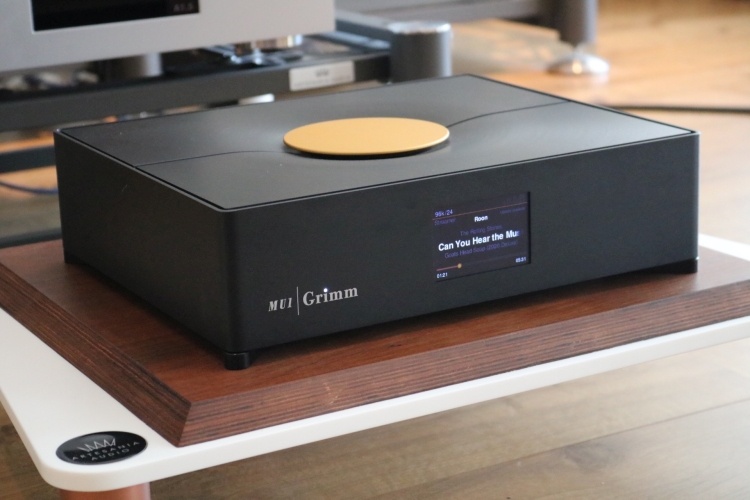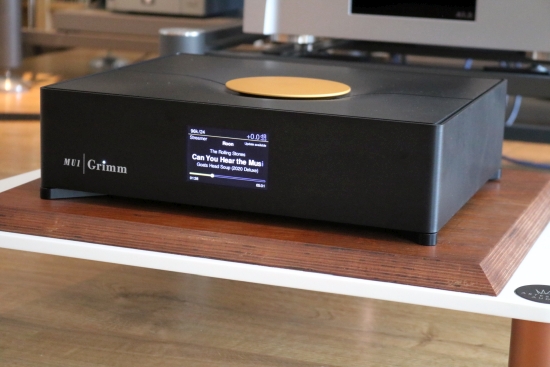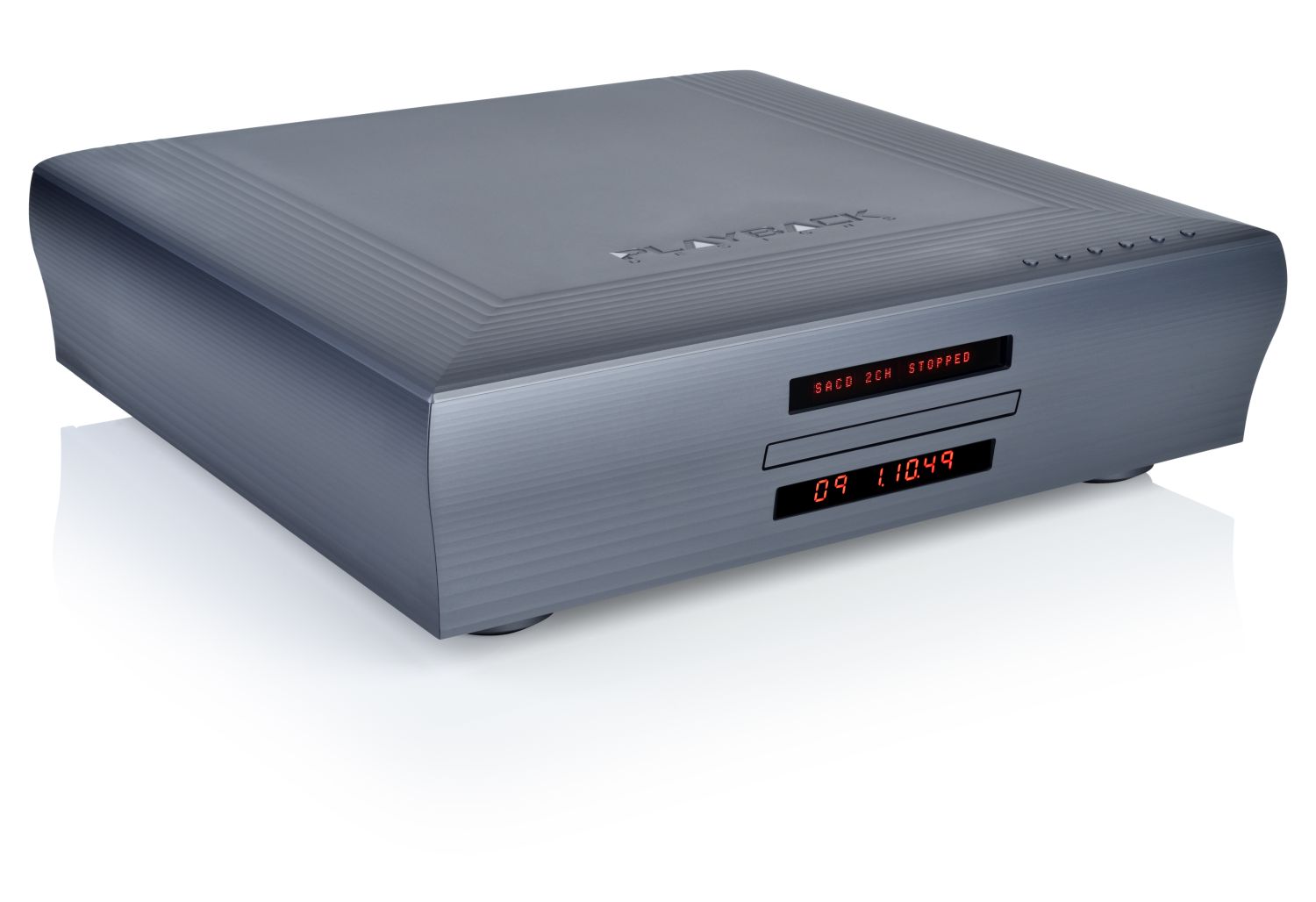
Review organized by Marc Loubeau / Prestige Audio Diffusion
Review sample provided by Terrason
Initial Review Sample Serial 13-0.002.016
Second Review Sample Serial 13-0.003.037
Retail price including VAT:
No internal storage: €9.800
Available SSD storage: 2 TB (€350) / 8 TB (€950)
Other storage sizes only on special request
After the Olive 04HD, the AudioAanZee Ultra Flow, Reference Flow, and Reference Flow MkII, the 432 EVO, the Aurender S10 and N10, the Pink Faun 2.16x, the Meridian Sooloos MC200, MD600, MS600, and 818, the Melco N1A/2 and N1ZH/2, the Euphony Buggy/Zotac, the Antipodes DX2, DS, EX, CX, and K50 Music Servers, and twice as many Streamers/Network Players, not to mention various server software and playback applications that I have tried throughout the years, I figured that, by now, surely, there’d be no more large surprises for me. Well, of course, that’s when a new server entered my premises and totally surprised me.
Grimm Audio
Founded in 2004 and based in Eindhoven, the Netherlands, Grimm Audio aims to use the collective forces of the greatest audio minds and to this day, all Grimm Audio products carry the joint insight of well-known scientists in the fields of audio electronics, acoustics, and physics.
The two key figures are Eelco Grimm and Guido Tent, respectively Creative Director and Technical Director of Grimm Audio. Together with a team of software-, electrical-, and mechanical engineers, they produce audio equipment that is refreshingly different while yielding high praise the world over.
Being Dutch myself, I can’t help but feel a little proud:-)
MU1 Backdrop
Designed to complement the Grimm Audio LS1 loudspeaker system, the MU1 has sort of inadvertently taken the audio world by storm. This is in no small amount thanks to the efforts of Ben van Leliveld who was positively raving about the product on every occasion and during every demo that he hosted. Indeed, it was through one of Ben’s demos at the Listening Matters showroom that I first laid eyes on the MU1, at that time combined with Zanden amplification and Kroma Audio loudspeakers. Later, I would hear the MU1 in the role envisioned by the design team, along with the LS1 speakers during one of the last demos at Garmt and Bjorn’s Beter Beeld & Geluid showroom before it closed down. While I was quite impressed with the performance of the MU1+LS1 system performance, it was impossible to pin down how much of this was attributable to the MU1. Up until this point, I’ll be honest and admit that I thought it was mostly hype, possibly even more so when Ben proclaimed the MU1 to be The One server worthy to sell your CD player for.
It wasn’t until a close friend and fellow audio reviewer obtained a MU1 for his review reference system that I really took notice. Like me, he had a hard time finding the ideal Music Server to work alongside his treasured CD player. We both feel that computer-based audio has made large strides but, somehow, still lags behind a good CD player in certain aspects. To be fair, if the CD player is of insufficient quality, it can also be the other way around, in many aspects, at least. Overall, though, there is something to CD playback that is less mechanical and stilted than any music server or streamer replay. Excuse me for not going into detail on this perception, as I’ve rambled on about this more than enough in my other Music Server reviews.
Anyway, in his quest to find the ideal Music Server, the friend auditioned the best servers and streamers that are currently available and since I had already been doing the same thing for over a decade, we decided to join forces and compare the best of the best. I went over there with my Antipodes K50 and my accumulated knowledge and, well, let’s say that I was in for a surprise.

MU1 Description
With the MU1, the goal was to set a new benchmark in music player design, not only in terms of sophistication but also in terms of sound quality. Grimm Audio selected Roon for the user interface and the associated audio engine for file- and stream playback. An alternative User Interface and audio engine will be added later. Music can be sourced from streaming services such as Qobuz and Tidal as well as from an external NAS or a USB thumb drive. Streaming from Qobuz sounds superb and in many cases identical to local playback. Local music can be added to an internal SSD that can be ordered in a 2TB or 8TB size.
Powered by a twin-PCB switching power supply developed in-house to provide the lowest possible jitter values, the MU1’s core is shaped by a NUC board that runs Linux and the Roon Core server component. Importantly, Grimm does not just rely on standard Linux or Roon packages. Refusing to use standard libraries, the Grimm team wrote their own code from the ground up. This is where the MU1 differs from other music servers and likely an important reason for why it sounds so superb.
Arguably, the actual core of the MU1 is its custom-designed FPGA interface board. Whereas many competing products use standard oscillators for FPGAs, Grimm uses a very high-quality Tentlabs oscillator for this task while using an ultra-low jitter proprietary Grimm audio oscillator as the main audio clock. The Grimm clock and associated circuitry are encapsulated in a fully shielded box.
It’s on this FPGA board where the MU1’s magic happens, with the FPGA interface accepting all file formats and sample rates from Roon in their native formats and converting them with a user-defined fixed multiplier (2x or 4x) using a “Pure Nyquist” decimation filter. The resulting signal is available on the rear via two AES/EBU outputs and an RJ45 output that is dedicated to the LS1 speaker system. The MU1 can also be used to stream to other Roon endpoints but, naturally, this bypasses the FPGA board and its beneficial processing.
The MU1 plays all the file formats that Roon supports, such as WAV and FLAC, and it has native support of PCM formats up to 8x the base rate (8FS or “DXD”) and of DSD formats up to DSD256. The FPGA processor will upsample 1FS and 2FS sources to 4FS and it will downsample 8FS and DSD or DXD formats to 4FS. In other words, there is no fixed sample rate and the used rate depends on the input rate. For instance, 44.1kHz will be output as 176.4, and 48kHz will be output as 192kHz while 96kHz will also be output as 192kHz. An input signal of 192kHz remains unchanged while higher sample rates will be downsampled.
While I can understand there may be those who object to the notion of oversampling and insisting on retaining the purity of the original signal, it’s worth noting that the vast majority of CD players and DAC’s have a built-in oversampling that is usually 4FS. Even the earliest Philips players, including those with 14-bit DACs, used fourfold oversampling. With that out of the way, the downsampling of very high sample rate source material might still sound strange but there’s a very simple explanation for this. It is the maximum rate that AES3 or S/PDIF will support. The Grimm Audio team performed elaborate tests and has concluded that the clock accuracy (low jitter) is much more important for the audible results than an even higher PCM sample rate or even DSD.
To make the magic of the FPGA board more widely available, the MU1 can also accept external inputs on AES/EBU and S/PDIF on cinch and TOSlink, and process these just like it does the internal Roon signal.








Hi Christiaan,
interesting review! Especially the comparison with the Aqua LinQ, which I own as well. Knowing the LinQ really well, it would be interesting to read how it compares with the latest and best implementation of the NAA + CORE module, allowing it to the the embedded HQPlayer on its own. If you have the chance, definitely ask for this upgrade – in my ears that’s a different level.
Best Robert
Hi Robert, as we speak, I am reviewing the Core+NAA module. And indeed, it is a very noticeable step up!
Hi Christiaan,
nice! Looking forward to your impressions. In my system, the
LinQ is connected via I2S to the La Scala MKII Optologic DAC – my perfect match with a sound signature more on the emotional/warmer side.
Best Robert
Hello Christiaan, thanks for another excellent review.
Any change of you reviewen the streamers from Hifi Rose?
regards Albert van Bentem
Hi Albert, I have no plans for that, but I will add the brand to the list of items that might deserve a review.
Hi Christian,
It was your review that takes away the last hordes and decide me to buy the Antipodes K50.
All my flacs on the internal SSD’s and only the ethernet connection for Roon updates and remote control. I use Squeezelite as player. The differences you describe with the K50 versus MU1 is what I do hear with the AES/EBU versus the I2S (HDMI) outputs.
I do use the fantastic Denafrips Terminator Plus which can do up/over sampling but I prefer the “rawer” NOS mode.
And there is something I do not like with this Grimm MU1; Updates (hard- and software) that can’t be implemented on the older units. The people that did buy these new and unknown server, paved the path for the upcoming innovations and should be “rewarded” for buying the first units.
Hello Christian,
I am in the market for a new Roon core server and have read your excellent reviews with interest. I currently use a SGC I7. But I have just auditioned a K50 for about a month.
I have ordered a Tambaqui Dac to replace my Bricasti and wondered if the Grimm might be a better match. However, I use convolution filters in Roon DSP and wonder if the I3 in the Grimm is underpowered?
Hi Jeff, the Tambaqui sure is a nice DAC, so long as it is used with an analog preamp. The MU1 and the K50 are both great but they have very different sonic presentations and which one is the better match will be a matter of personal preference and perhaps system synergy. FWIW, the MU1 in its current incarnation sounds clean, fast and very transparent and I would describe the Tambaqui similarly, albeit with a touch of gentle smoothness. The K50, on the other hand, has a full, smooth, and relaxed sound. Do you want to maximize transparency, articulation, resolution, and neutrality? Then the Grimm might be ideal. Do you want to pull the sound more toward fullnes, deeper tonal saturation, and liquidity, then the K50 could be more ideal. Regarding the processing power, I’m afraid I can’t provide a definitive answer as I do not currently use convolution filters. However, I have used these in the distant past with a much older and simpler machine and do not recall any slowing down or snappiness with the UI or the music playback.
Hi Christiaan, what is your impression of the latest Roon (2.0)/ firmware (1.5) updates?
Hi Vincent, Roon SQ is always going up and down, or sideways, depending on your view. And as it turns out, the MU1 is also sensitive to these changes in Roon SQ. For me, 2.0 sounds smoother and more polite than 1.8 (which some will like) but also less forceful and incisive (which I do not like). But I have been hearing small improvements with the latest crop of Roon updates. It’s not back to how 1.8 was at its peak, but it’s better than it was with the first incarnation of 2.0.
For me, the latest Grimm update (1.5) has barely had an impact on the sound quality from the last version (1.4). I thought I did hear ever so slightly duller treble but it’s important to note that the simple act of restarting can also subtly affect the sound, at least for a short period of time. In my successive day-to-day listening, the MU feels the same as it did with 1.4. If there really is a delta then it’s too small to reliably detect or describe. I was also happy to find that switching on/off the second output seems to be transparent.
For me, the last Roon update was a good one: detail retrieval got beter, and separation of instruments improved. There is no way to travel in history and go back to 1.8 I guess..
Thanks for sharing your impressions!
Hi Christiaan
Hope you are doing well. Love your site, reviews, methodology and style.
Have you had the chance to hear the Rockna wavedream net server, and if so how would it compare to the Grimm MU1 ?
Cheers
David
Alas, I have not heard any Rockna equipment yet.
Hi Christiaan, though this is not the right thread for my question: but why did you never put the Taiko Extreme to the test? And what about the newly introduced Audiophool Music Server 2.1?
Hi Vincent, I work for Taiko Audio. As such, there would be a conflict of interest:-) I have not heard the AudioPhool nor have I been approached by them.
I see, thats a really shame since I had them both in and compared last week. I was really curious about your findings. Since the TE is considered to be the ultimate reference streamer, it makes other comparisons somehow less relevant. But I get your point regarding CoI.
My main takeaway: the Taiko Extreme SGM has crazy resolution and black background combined with larger than life soundstage. The first guitar plucks in Private Investigations – Dire Straits sounded like real metal strings where the MU1 like plastics. Though better in nearly every aspect, the MU1 on the other hand offers a more relaxed presentation and more forgiving with less ‘audiophile’ mastered tracks. For example Michael Jackson – Thriller was a better performance on the MU1.
The TE performance reminded me of the moment using a TDK SA-X cassette tape for the first time on My first Sony walkman 🙂
Hi Christiaan,
I love your reviews and think that you write the best reviews for digital gear.
I was ready to buy MU1 but am backing off after the May 5, 2024 update. I thought that Grimm eliminated all other influences on SQ by their processing and reclocking of outputs. It does not seem to be happening based on your May update.
Are you using Roon only for the music library management and to pass unmodified data to the Grimm board, that is, without any processing or over sampling by Roon?
Any comments are welcome.
Regards,
Tony
Hi Tony, thanks for the nice feedback. It’s a tricky field. Purely theoretically, certain deviations are accounted for in margings, but large deviations should not occur. However, as I find with any gear, even digital gear, there are always influences, and circumstances matter. Depending on who you ask, my observations are spot-on, exaggerated, or not even possible. I have two friends with MU1s and one of them agrees with my findings while the other does not notice any differences. At the end of the day, all I can do is relay what I hear. But importantly, even though it changed since I first reviewed it, the MU1 is still my favorite Roon server.
Roon’s DSP functionality is superb and can come in handy when your room is not ideal and remodeling or treatment is out of the question. Using Roon DSP, I made my then non-SAM Genelec speakers sound really good even though they were in a narrow kitchen area. For my main system, however, I prefer not to use DSP or any Roon plugins, as they have an audible impact. Then again, if the room has severe issues, the net result with DSP can still be much better than without it.
When using the MU1 with its AES/EBU output, I have the Grimm’s oversampling set to none. But currently, the MU1 sounds best to me when streaming to the CH Precision’s C1.2 RoonReady Ethernet input. Even in this capacity, the MU1 has a large advantage over running Roon Core on a standard PC.